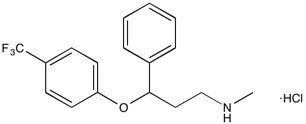Fluoxetine HCl | Serotonin reuptake inhibitor
NMR (Conforms)

Available Options
| Size: | Price | Quantity | |
|---|---|---|---|
| 100 mg | $50.00 | ||
| 1 gram | $200.00 |
Fluoxetine HCl (56296-78-7) is a selective serotonin reuptake inhibitor (SSRI) with high selectivity for the serotonin transporter (Kd=0.81 nM) over the norepinephrine (Kd=240 nM) and dopamine (Kd=3.6 mM) transporters.1 A clinically useful antidepressive agent.2 Has shown some potential in autism spectrum disorders.3 Attenuates neuroinflammation in early brain injury after subarachnoid hemorrhage.4 Orally active and active in vivo. Increases proliferation of neuronal precursors derived from human embryonic stem cells, inducing differentiation and strongly enhancing neuronal characteristics.5
References/Citations:
1) Tatsumi et al. (1997), Pharmacological profile of antidepressants and related compounds at human monoamine transporters; Eur. J. Pharmacol., 340 249
2) Benfield et al. (1986), Fluoxetine. A review of its pharmacodynamic and pharmacokinetic properties, and therapeutic efficacy in depressive illness; Drugs, 32 481
3) Benvenuto et al. (2013), Pharmacotherapy of autism spectrum disorders; Brain Dev., 35 119
4) Liu et al. (2018), Fluoxetine attenuates neuroinflammation in early brain injury after subarachnoid hemorrhage: a possible role for the regulation of TLR4/MyD88/NFkB signaling pathway; J. Neuroinflammation, 15 347
5) Chang et al. (2010), Increased cellular turnover in response to fluoxetine in neuronal precursors derived from human embryonic stem cells; Prog. Int. J. Dev. Biol., 54 707
NMR (Conforms)
Safety Data Sheet:
Product Data Sheet:
Materials provided by Focus Biomolecules are for laboratory research use only and are not intended for human or veterinary applications. Please note that we do not sell to individuals and that all orders placed by non-research organizations will incur a $20 restocking/refund fee
Fluoxetine HCl (56296-78-7) is a selective serotonin reuptake inhibitor (SSRI) with high selectivity for the serotonin transporter (Kd=0.81 nM) over the norepinephrine (Kd=240 nM) and dopamine (Kd=3.6 mM) transporters.1 A clinically useful antidepressive agent.2 Has shown some potential in autism spectrum disorders.3 Attenuates neuroinflammation in early brain injury after subarachnoid hemorrhage.4 Orally active and active in vivo. Increases proliferation of neuronal precursors derived from human embryonic stem cells, inducing differentiation and strongly enhancing neuronal characteristics.5
References/Citations:
1) Tatsumi et al. (1997), Pharmacological profile of antidepressants and related compounds at human monoamine transporters; Eur. J. Pharmacol., 340 249
2) Benfield et al. (1986), Fluoxetine. A review of its pharmacodynamic and pharmacokinetic properties, and therapeutic efficacy in depressive illness; Drugs, 32 481
3) Benvenuto et al. (2013), Pharmacotherapy of autism spectrum disorders; Brain Dev., 35 119
4) Liu et al. (2018), Fluoxetine attenuates neuroinflammation in early brain injury after subarachnoid hemorrhage: a possible role for the regulation of TLR4/MyD88/NFkB signaling pathway; J. Neuroinflammation, 15 347
5) Chang et al. (2010), Increased cellular turnover in response to fluoxetine in neuronal precursors derived from human embryonic stem cells; Prog. Int. J. Dev. Biol., 54 707
Calculate the molar concentration, mass or volume in a solution.
Concentration × Volume × Molecular Weight = Mass
Focus Biomolecules • Plymouth Meeting, PA USA • 1-855-FOCUS21
Focus Biomolecules
Plymouth Meeting, PA USA
1-855-FOCUS21
Website Created by Advanta Advertising LLC.

